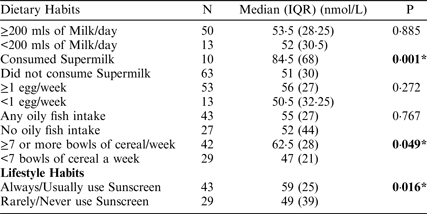Serum 25-hydroxyvitamin D (25OHD) is the main circulating form of vitamin D in the blood. Recent research suggests that inadequate vitamin D status is common in early childhood(Reference Ward and Ladhani1). Vitamin D status in adults is determined by numerous factors such as oral intake, sun exposure, and body composition. Research is limited regarding determinants of 25OHD status in young children.
Analysis was carried out on 79 children from the ROLO Kids study in Dublin, Ireland. Blood samples were collected for serum 25OHD estimation. Dietary intakes and dietary habits were measured using a food frequency questionnaire and lifestyle questionnaire completed by the mother. Child weight, height, and skinfolds were measured by trained researchers. Statistical analysis included Spearman correlations and Mann-Whitney U tests.
61% of the participants had sufficient 25OHD (≥50 nmol/L), using the 2011 IOM report on dietary reference intakes for calcium and vitamin D as the basis for interpretation(Reference Ross and Manson2). Neither reported dietary vitamin D nor calcium intake was significantly associated with 25OHD. Intakes of standard milk, eggs, and oily fish were not associated with 25OHD, but the consumption of fortified milk, and more than 7 bowls of cereal a week were independently associated with higher 25OHD (p < 0·001 and p = 0·049, respectively). There was no association of body composition at 5 years with 25OHD. Sun exposure (measured as obtaining at least half an hour of sun per day) was not significantly associated with 25OHD, but reported use of sunscreen was associated with increased 25OHD (p = 0·016).
Table 1. Comparing dietary habits and the association with serum 25OHD concentrations in 5-year old children.

P values were calculated using Mann Whitney-U tests.
*P-value is significant at < 0·05.
These findings suggest the primacy of dietary and lifestyle habits as determinants of 25OHD in early childhood. Further education surrounding dietary habits may be useful to ensure sufficient vitamin D status within this age group.



